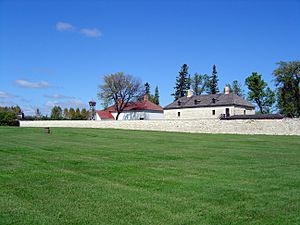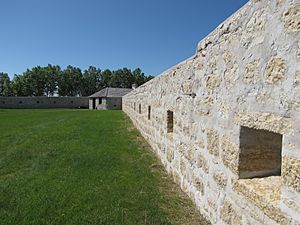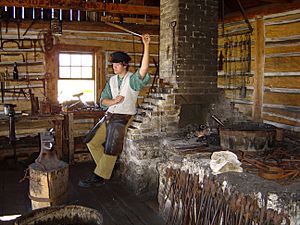Lower Fort Garry facts for kids
Quick facts for kids Lower Fort Garry |
|
|---|---|

View from outside Lower Fort Garry
|
|
| Location | 5925 Highway 9 St. Andrews, Manitoba, Canada, R1A 4A8 |
| Built | 1830 |
| Original use | HBC trading fort |
| Governing body | Parks Canada |
| Lua error in Module:Location_map at line 420: attempt to index field 'wikibase' (a nil value). | |
| Official name: Lower Fort Garry National Historic Site of Canada | |
| Designated: | 31 May 1950 |
Lower Fort Garry is a very old and important place in Canada. It was built in 1830 by the Hudson's Bay Company (HBC). This company was a big trading business in early Canada. The fort is located on the west side of the Red River. It is about 32 kilometers (20 miles) north of where the original Fort Garry once stood. Today, that area is part of Winnipeg, Manitoba. A very important agreement, Treaty 1, was signed at Lower Fort Garry.
The first Fort Garry was destroyed by a huge flood in 1826. Because of this, the governor of the Hudson's Bay Company, George Simpson, looked for a safer spot. He chose the location for Lower Fort Garry because it was on higher ground. It was also below the St. Andrew's Rapids. This meant heavy fur packs and York boats did not need to be carried around the rapids. However, the fort did not become the main center as planned. Most people lived closer to The Forks, where the first fort was. They found it too far to travel to the new fort. So, Upper Fort Garry was later rebuilt with stone near the original site at The Forks.
Contents
The Story of Lower Fort Garry
Building the Fort (1830-1850)
The first buildings at Lower Fort Garry were finished in 1830. These included the "fur loft," which was a store and warehouse. There was also the "Big House," a large home for the governor or other important HBC leaders. Later, more buildings were added, like another warehouse and a men's house.
The fort's famous stone walls were completed in the 1840s. Inside the walls, an icehouse, a place to store gunpowder, a bakehouse, and warehouse towers were built. These walls were not for fighting. They were built to make the fort look grand and important. This impressed both local traders and visiting HBC officers. Many buildings were made from limestone, which was easy to find nearby. The fort also shows examples of special building styles. These include Red River Frame construction and Half-timbered construction.
Lower Fort Garry did some fur trading. But its main job was to be a supply center for the Red River settlement. It also supplied the local Cree, Anishinaabe, Métis, and European people. Many furs came from other areas. They were repacked at the fort and sent to England through York Factory. The fort also traded important goods to farmers and hunters. In return, they received food that was used for HBC trips to the north.
Sometimes, there were situations that needed military help. Lower Fort Garry was often chosen as a base. In 1846, British soldiers were sent to the fort. This happened because of a disagreement with the United States over the border of the Oregon Territory. However, some people think the soldiers were really sent to scare local traders. Trading with anyone but the HBC was against the rules then. By the time the soldiers arrived in 1846, the border issue was mostly settled. The soldiers helped finish building the fort's walls, which were done in 1848.
Important Events (1851-1884)
By the 1860s, the fort became a busy industrial place. It had a flour mill, a sawmill, a blacksmith's shop, and a brewery. When the Red River Rebellion began in 1870, Louis Riel took control of Upper Fort Garry. The Quebec Rifles, a military group, took control of Lower Fort Garry. No battles or fights ever happened at Lower Fort Garry itself. It remained a peaceful place.
On August 3, 1871, the first treaty in Western Canada was signed at Lower Fort Garry. This was between the Canadian government and seven chiefs of the Ojibway (Saulteaux) and Swampy Cree First Nations. This agreement, called Indian Treaty No. 1, transferred land that is now part of Manitoba. The treaty aimed to allow European settlers to live peacefully on the prairies. It also aimed to provide First Nations people with land, resources, and other things they needed to survive. Soon after the treaty was made, both sides disagreed on what it truly meant.
Indian Treaty No. 1 was the first of many similar treaties in Western Canada. A special plaque outside the Visitor Reception Centre remembers this important event.
Members of the North-West Mounted Police (NWMP) trained at the fort during the winter of 1873-1874. Many of these NWMP members had been at the fort before during the 1870 rebellion. This included Inspector James F. MacLeod. The first group of Mounties arrived at Lower Fort Garry on October 22, 1873. On November 3, they officially joined and started their training. They spent the cold winter practicing drills and learning to ride horses. The ground was very hard, which made falling off a horse quite difficult! By June of the next year, they were ready to meet Commissioner G.A. French and other groups at Fort Dufferin. After this, the fort was given back to the Canadian Militia.
Modern Times (1885-Present)
Over the years, Lower Fort Garry has been used for many different things. It was once a prison and even a mental health hospital from 1885 to 1886. One well-known person who stayed there was Honoré Jaxon. He was Louis Riel's secretary and was found not guilty of a serious charge because of his mental health after the North-West Rebellion. The fort was also a home for HBC staff and later a golf course and country club from 1911 to 1963.
In 1929, a plaque was put up to mark the fort as a historic site. The Hudson's Bay Company owned the fort until 1951. Then, they gave it to the Canadian government. In 1958, it was officially named a National Historic Site. In 2011, Canada's History magazine called it one of the top 10 National Historic Sites in the country.
Today, from May to September, you can visit Lower Fort Garry. People dressed in old-fashioned clothes act out what life was like in the early 1850s. This was when Eden Colvile was the governor of the HBC and lived at the fort. You can see the original buildings and walls. There are also hands-on activities and old furniture from that time. This helps visitors imagine what life was like long ago.
See also
- List of forts



